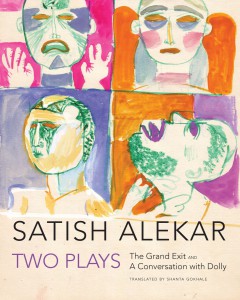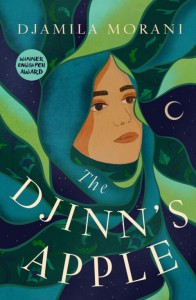This month, our selected titles of new publications carry wisdom, mystery, and humour. Below, find reviews of plays by one of India’s most accomplished and innovative playwrights; a compilation of interview with the inimitable Etel Adnan, conducted by Laure Adler; and a PEN Translates Award-winning novel of revenge and self-discovery, set in the Abbasid period.

Two Plays: The Grand Exit and A Conversation with Dolly by Satish Alekar, translated from the Marathi by Shanta Gokhale, Seagull Books, 2024
Review by Areeb Ahmad, Editor-at-Large for India
This nifty volume of plays collects two of Alekar’s works, “Mahanirvan” and “Thakishi Samvad”, written forty-six years apart—Born in 1949, Satish Vasant Alekar is a Marathi playwright, actor, theatre director. He was a founding member of the Theatre Academy of Pune and is well-known plays such as for Mahapoor, Begum Barve, Atirekee, and Pidhijat. He is considered among the most significant playwrights in modern Marathi and Indian theatre, along with Mahesh Elkunchwar and Vijay Tendulkar, and lately, he has come to be recognised for his acting in Marathi and Hindi feature films.
“Mahanirvan” or “The Grand Exit” was first performed in 1974, and is a play where a dead man has more dialogue than any living character. The description on the cover is not wrong to equate the character with Sophocles’ Antigone, for he also strongly insists on the method of his last rites; Bhaurao wants to be traditionally cremated at the shamshan ghat, but the cremation ground is in the process of being privatised. Thus, the dead—or rather their relatives—are now being redirected to a new facility which uses electrical incineration.
So Bhaurao lingers around as his body malingers, rotting and fly-infested, while his wife Ramaa grieves intensely, coming to terms with the sudden loss, and his son, Nana, tries to convince him to just go ahead with the cremation, and pass on. While working on the play, Alekar had realised that a dead man cannot speak prose, so Bhau’s dialogues instead take the poetic form—one resembling keertans (religious recitations).
One can think of “The Grand Exit” as Waiting For Godot meets Santa Clarita Diet—although Alekar would probably reject the absurdist label. Still, the play breaks the fourth wall in the most delightful ways; soliloquies are overheard by others, characters interject ongoing action to call curtains, and stage directions are directly explained. The level of meta-commentary jolts the reader out of their complacent passive activity of reading, and one can imagine the effect it would have had on audiences during performances. No wonder the play went on to have over four hundred shows in its original run.
On the twenty-fifth anniversary of “Mahanirvan”, Alekar opened up about his writing process to Rekha Inamdar-Sane: “I decided. . . to circumvent all the clutter and simply do theatre. . . My aim is to engage the audience completely without bowing an inch to their demands.” He certainly succeeds in that regard; the constantly changing tempo of the play keeps you on your toes, and there is plenty of dark humour to go around without poisoning the narrative with ponderings on the meaninglessness of life. After all, it is the living dead who are calling the shots.
In an interview with translator Shanta Gokhale, Satish Alekar reveals the trigger for the second play in this collection, “Thakishi Samvad” or “A Conversation with Dolly”: the brutal murders of Narendra Dabholkar, Govind Pansare, M. M. Kalburgi, and Gauri Lankesh. These authors and activists were victims of politically-motivated killings within a span of four years (2013-2017) in an increasingly right-wing India. He asserts: “To think differently became a crime. . . Dissent was no longer respected. . . [I was] very angry. And restless. I had to find an outlet for my anger.” Taking place during the Covid-19 pandemic, the elderly protagonist with a terminal coronavirus diagnosis is a stand-in for the writer facing death in a new political atmosphere. All alone in the house and locked down, he embodies the everyman figure, a pillar of mediocrity who has blown with the wind all his life and has never taken a definite stance on anything. His one company is the titular Dolly, an Alexa-esque AI personal assistant—but she is no companion, only a voice who makes sense of all the Amazon boxes piling up around the old man, containing items ranging from oximeters and masks to full sets of PPE. While she takes care of him, Dolly is also the one who breaks the fourth wall, directly addressing the audience multiple times and crediting them for the old man’s loquacity, as the hours count down.
The narrative of the play also centres around the kargota, or the black silk thread traditionally tied at the waist of a male child to ward off the evil eye. The old man, fascinated by the cord and its socio-literary history, researches the kargota’s presence throughout history, from ancient China to Mughal India to the current BJP government in India to the murder of the George Floyd—and through it, an alternative series of events is created. In this turn, Alekar intended to show how “historical facts are being subverted and replaced by fantasy. . . That’s what the new history is all about—twisting some facts and suppressing others to fit the newly constructed narrative.”
“A Conversation with Dolly” contains multiple musical interludes in which popular Hindi-Marathi songs are played, and the stage directions suggest that suitable accompanying visuals can be displayed on screen. The old man’s kargota presentation is intended to be projected, and the various visual examples—usually taken from unrelated Wikipedia Commons files—are provided within the text through QR codes. With potential to be a path-breaking multimedia theatrical experience, it does not come as a surprise that “A Conversation with Dolly” is Satish Alekar’s first play to be published prior to its actual performance. In its innovation and lucid storytelling, it proves that the playwright’s creative juices are still now flowing unabated, at full strength.

The Beauty of Light: Interviews with Etel Adnan by Laure Adler, translated from the French by Ethan Mitchell, Nightboat Books, 2024
Review by Christina Chatzitheodorou, Editor-at-Large for Greece
In The Beauty of Light, poet and painter Etel Adnan recalls her youth in Beirut, Lebanon, before moving gradually through her years in Paris, New York, and California. This intimate, extended conversation, conducted with journalist and producer Laure Adler, opens up Adnan’s personal views on various topics: war, history, philosophy, painting, poetry, and feminism. Adler mentions how Adnan caught her eye under “somewhat worldly circumstances, surrounded by famous artists and important gallerists. Everyone was talking but her.” While they initially met in a professional setting while working on an issue of L’Entretien, the friendship evolved naturally through long discussions. When the opportunity emerged for Adler to make a book with an artist, Adnan naturally came to mind. As she recalls: “Here was an artist, to be sure, but as young people say these days, ‘not just’.”
Almost ten years ago, when I was reading Shadow of the Wind by Carlos Ruiz Zafón, I came across a powerful line: “Books are mirrors, you only see in them what you already have inside you.” That phrase stayed with me throughout the years, and transformed the way I was “looking” at books. I was always trying to understand how reality could mirror the things I read, or why certain texts made me feel certain ways; sometimes this was an easy task, but other times it was much harder to comprehend my affinity to the story or the writer. When it comes to Etel Adnan and her works, however, it was always easy to identify with her writing. In many of her works—including The Beauty of Light—she speaks of her Greek and Turkish heritage, stressing the in-between in which she grew up: “We spoke Turkish in Beirut, at home, but my mother spoke to me in Greek, naturally. I grew up this way until the age of twenty, until twenty-four even, speaking Greek and Turkish. . .”
From the first interview of the book, she recalls her mother: “She saw Smyrna burn when she was scarcely twenty-four years old. She thought only of Smyrna. . . Her friends came to the house and always repeated: ‘The grapes were better in Smyrna; the fish were better in Smyrna. . .’ She was possessed. . .” Through these talks and intimate revelations, we manage to see a glimpse of cities both lived and imagined through Adnan’s eyes, accompanied by what she likes, what she does not, what makes her feel something, and what leaves her totally indifferent. We learn about her relationship with the mountains and her relationship with the sea, within which she speaks of as a local of the Mediterranean, a sea that always holds a special place in her works: “The colors of the Mediterranean: it’s a miracle, it’s so beautiful. The dark blue of the Mediterranean, it’s unbelievable.”
We come also to understand how she writes poetry, what provides her with inspiration, and what moves her to become a poem: “I’m asked sometimes: ‘Why is there so much history of contemporary war in your poetry?’ I’ve answered: ‘Because it’s not me that writes it, it’s history that writes it.’” She later explains further: “I was even at a press conference that De Gaulle gave in Beirut, and . . . I had the sense of being active in history, of living it. . . For fifteen years we spent our time listening to the war on the radio, so how could I not think about it?”
Further, she compares her two passions, writing and painting, explaining how the two of them have occupied different spaces in her life. While writing has been closely related to the historical context it emerges from, painting was for Adnan a deliberate act: “So, in my case, writing has been more tragic, more linked with the real world, while painting is exhilarating.” While she writes as a politically engaged subject “with the world as it is”, she paints in a more innocent way—as if wishing to avoid the heartbreaks surrounding life. Adler asks and re-asks when she feels she needs a clarification, but she does not steal the spotlight. Instead, the whole book centres on Adnan: we learn about Etel and “her emotions as the basis of her creation”.
In one of the concluding passages, Adler asks Adnan to define what a great love is, and if she has ever experienced one. Her answer is expectedly honest: “. . . a sort of obsession that swallows everything; like I said, it’s almost painful. It takes up lots of room. It takes up all the room.” Yet a great love for Etel is not only confined to the desires between human beings; for her, it is possible to be in love with life, with the world: “My first passion was the Mediterranean.” In these revealing, candid talks, Adnan presents her Beirut, amidst all the other places of the world, as a city to fall in love and to fall in love with: chaotic, caught up between extremes, and entirely worth the journey.

The Djinn’s Apple by Djamila Morani, translated from the Arabic by Sawad Hussain, Neem Tree Press, 2024
Review by Rene Esau Sanchez, Editor-at-Large (Mexico)
Although The Djinn’s Apple is not Djamila Morani’s first novel, it represents the Algerian novelist’s debut into English—while earning translator Sawad Hussain the remarkable achievement of a English PEN Award. The novel takes place in the Abbasid Period, in which Baghdad was one of the most important centers of the Islamic world; this historical setting is turned by Morani into the perfect stage to tell a story where political intrigue intertwines with culture, science, and magic. As such, these many sources of inspiration turn The Djinn’s Apple into a work that oscillates between genres.
The novel presents itself as a murder mystery, but as the narrative unfolds, it becomes more of a coming-of-age novel, wherein the protagonist Nardeen matures and grows through her confrontations with death. She is part of the Baramikas, a powerful family of Persian viziers that helped the caliph Harun Al-Rashid gain power, but who later fell out of his good graces. This led to the tragic murder of Nardeen’s entire family, and she is left to take revenge on whoever demanded their assassination.
There is definitive mystery surrounding this loss, seemingly bound to a lost book and the famous Djinn’s Apple, but death is the real leitmotif of Morani’s story. To kill, to die, to heal: Nardeen seeks to understand her world and her purpose through these actions, and such violence and recovery is the only way she can heal her wounds and face the political intrigues in which she has been implicated. The brutal killings of her family follow Nardeen like a shadow, shaping her destiny as an avenger, but also eventually as a medic; the tragedy ultimately passes on the value of taking care of others. And although this dark past marks a significant part of her development, another thread that weaves through Nardeen’s life is of love, and how new affections and intimacies can develop. This comes through the meeting between Nardeen and Muallim Ishaq, a medic from Baghdad’s Bimaristan—the medieval Islamic hospitals—who takes her under his wing after the tragedy. He later becomes her teacher, mentor, and, in a way, her new father.
As with the rest of the novel, there is something about Muallim Ishaq that shifts and surprises; he is warm and kind, but also stubborn and secretive. The archetype of the old wise man falls short, as his grey morality and his determination to help Nardeen in her quest for vengeance occasionally come off as malicious. However, he is ultimately responsible for giving Nardeen the opportunity to achieve her full potential. He gives her a place in the Bimaristan, allows her to help the sick, and always reminds her of the importance of being patient, telling her: “If you want to get rid of your enemies, you’ve got to live long enough to do so. And for you to survive, you must keep your sorrows to yourself, deep within. You won’t reach Al-Aasefi unless you increase your knowledge and resourcefulness.”
This patience and delay of Nardeen’s vengeance might make her seem like a passive protagonist, and her lack of decisions does sometime put her in the position of witness instead of instigator. However, the appearance of Shuaib, a former student of Muallim Ishaq, slowly forces her to be more active and make important decisions regarding politics, medicine, and her personal life.
Throughout, Nardeen reflects on her role within the story: “Maybe because I didn’t choose the beginning of the story, my hands were clean of all the blood that was spilled. But the finish to come was in my hands, and I was going to choose how it would all end.” This realization marks her stepping into adulthood, and what follows begs the question: “Did she really avenge her family?”
Morani has made full use of a rich and gripping history to create this fiction, resulting in the vivid depiction of a period where magic, religion, politics, science, and culture could all intertwine in one’s own life.
*****
Read more on the Asymptote blog:

